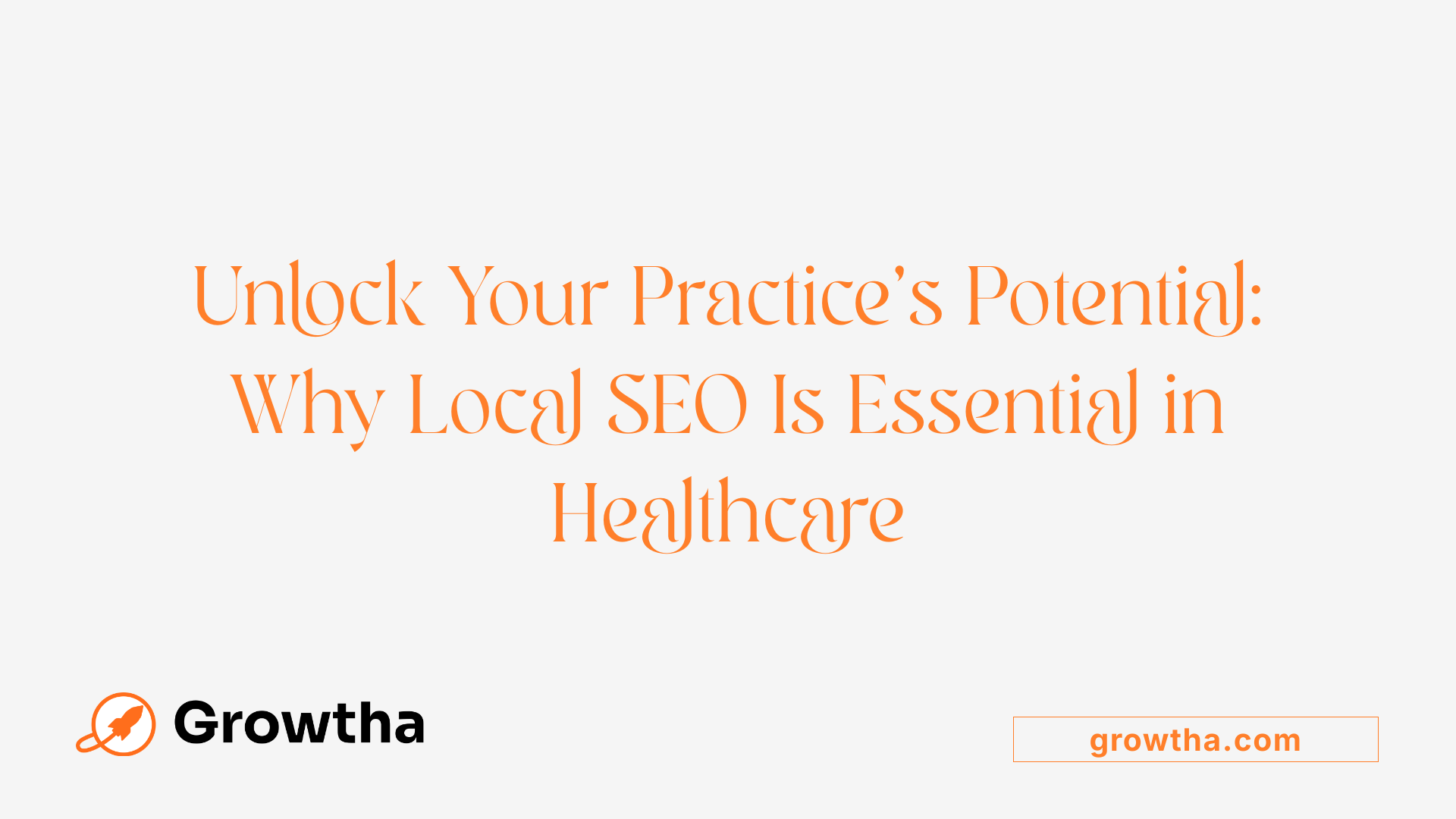Local SEO for Healthcare Practices Explained
Boost Your Practice’s Presence with Local SEO Strategies


Local SEO for Healthcare Practices Explained
Understanding the Power of Local SEO in Healthcare
In an increasingly digital world, local SEO has become an essential component for healthcare practices aiming to attract nearby patients and stand out in their communities. This article explores the fundamentals of local SEO, specific strategies tailored for healthcare providers, the benefits of implementing these tactics, and best practices to ensure ongoing success.
Defining Local SEO and Its Mechanics

What is local SEO and how does it work?
Local SEO is a specialized branch of search engine optimization focused on enhancing a healthcare practice’s online presence within its local community. This process helps healthcare providers appear prominently in search results for location-specific queries, like 'pediatric dentist near me' or 'urgent care in downtown.'
The core of local SEO involves optimizing several online assets. A primary tool is the Google Business Profile (formerly Google My Business), where practices claim their listing, verify their information, and keep it updated. They add essential details such as practice name, address, hours, services, and high-quality photos to boost visibility.
Beyond Google, effective local SEO incorporates managing citations across directories like Yelp, Zocdoc, and Healthgrades. Consistent NAP (name, address, phone number) details across all platforms reinforce credibility with search engines and patients alike.
Gathering positive patient reviews is crucial—reviews influence both reputation and search rankings. Encouraging satisfied patients to leave feedback on Google, Yelp, and other sites builds trust and improves the practice’s standing.
Websites also play a vital role. Creating locally targeted content, such as blog posts about community health issues or location-specific service pages, enhances relevance. Incorporating local keywords and schema markup helps search engines understand the practice’s location and offerings, further improving ranking.
The result? Healthcare practices increase their visibility to local patients actively seeking nearby services. This targeted online presence can lead to more appointments, higher foot traffic, and competitive advantage in their community.
How does local search differ from general SEO?
While general SEO focuses on broad visibility across the entire internet, local SEO hones in on attracting customers within a specific geographical area. Ordinary SEO might aim for keywords like "best family doctor" or "dental clinic," targeting a wide audience.
In contrast, local SEO emphasizes location-relevant keywords such as "pediatrician in Brooklyn" or "emergency dentist near Central Park." The strategies involve optimizing maps, local citations, reviews, and location-specific content.
Essential differences include:
- The importance of Google Maps and local packs in local SEO.
- The need for consistent business listing information across multiple directories.
- Greater emphasis on reviews and community engagement.
- Use of local schema markup to inform search engines about the business location.
By focusing on the local intent of searches, healthcare providers can connect more effectively with nearby patients, boosting appointment bookings and community trust.
The Significance of Local SEO in Healthcare

Why is local SEO particularly important for healthcare practices?
Healthcare practices primarily serve their immediate community, with patients often seeking providers nearby their homes or workplaces. Local SEO is crucial because it helps these practices appear prominently when potential patients perform searches like 'dentist near me' or 'urgent care in [city].' By optimizing for local search, healthcare providers can increase their online visibility in their geographical area, making it easier for prospective patients to find and choose their services.
Google's local search features, such as the Local Pack and Google Maps, prioritize nearby businesses that are optimized with accurate and complete profiles. This means that practices that actively work on their local SEO stand a better chance of showing up in relevant search results, capturing the attention of local patients actively seeking healthcare services.
Patient preferences and proximity importance
Most patients prefer healthcare providers who are conveniently located close to their home or office. Proximity significantly influences their choice, trust, and convenience. About 72% of consumers who conduct local searches visit a location within five miles, highlighting the importance of being visible in local results.
Practices that optimize their Google Business Profile, create location-specific content, and maintain consistent citations across directories significantly increase their chances of attracting these nearby patients. Furthermore, local SEO strategies such as encouraging patient reviews, creating localized website pages, and utilizing local schema markup help build trust and credibility, making it more likely that nearby residents will schedule appointments.
In conclusion, local SEO is a vital tool for healthcare practices striving to connect with their community. It ensures they appear where local patients are searching and helps build a trusted reputation within the neighborhood.
Strategies and Techniques Tailored for Healthcare Providers
What are the main strategies for effective local SEO in healthcare practices?
Successful local SEO for healthcare providers revolves around several essential tactics. First, claiming and optimizing the Google Business Profile (GBP) is fundamental. This process includes verifying your practice’s listing, ensuring all the information—such as practice name, address, phone number (NAP), practicing hours, and services—is accurate and current. Uploading high-quality photos and regularly managing patient reviews are crucial steps to enhance credibility and improve rankings in local search results.
Creating location-specific web pages is another vital strategy. These pages should feature relevant, community-focused content, incorporate local keywords (such as city or neighborhood names), and embed maps to facilitate easy navigation. This approach makes your practice more discoverable when individuals search for nearby healthcare services.
Managing citations—mentions of your practice’s NAP across various online directories like Yelp, Healthgrades, Zocdoc, and Google Maps—is essential for local SEO success. Consistency across these listings signals trustworthiness to search engines.
Furthermore, implementing structured data, also known as schema markup, helps search engines understand your practice’s details more effectively, leading to better visibility in local results.
Website optimization should include responsive design for mobile devices, integration of local keywords in headers and meta descriptions, and engaging content marketing activities. Promoting your practice through social media platforms and geo-tags increases local engagement.
Regular performance monitoring with tools like Google Analytics and Search Console enables you to tweak your strategies, address areas for improvement, and sustain your visibility in local search rankings.
In essence, a combination of profile optimization, consistent citation management, localized website content, schema markup, and ongoing analytics forms the backbone of effective local SEO tactics suited for healthcare providers.
Benefits of Local SEO for Healthcare Practices

What are the benefits of implementing local SEO for healthcare practices?
Local SEO plays a crucial role in how healthcare practices attract and retain patients in their community. By optimizing online presence through various strategies, practices can significantly improve their visibility in local search results. This is especially important because many patients prefer providers close to their home or workplace.
One of the primary advantages is increased visibility and easier patient discovery. When a practice claims and enhances its Google Business Profile—with accurate details, high-quality photos, and encouraging positive reviews—it appears more prominently on Google Maps and local search result pages. This enhanced presence makes it easier for nearby patients to find relevant services quickly.
In addition, local SEO helps build trust and credibility. Having a well-maintained profile with verified information and patient reviews fosters confidence among prospective patients. Also, the inclusion of location-specific keywords in website content and service pages improves relevance, making the practice more likely to appear in searches like ‘dentist near me’ or ‘urgent care in [city].’
Furthermore, local SEO is highly cost-effective. Unlike broad marketing campaigns, optimizing for local search delivers targeted traffic, reducing wasted expenditure on less relevant audiences. This targeted approach can lead to more online appointments and foot traffic, increasing patient engagement.
Maintaining consistent business information across online directories—such as Yelp, Healthgrades, and Zocdoc—further boosts search rankings and customer trust. Ultimately, local SEO is an ongoing strategy that supports sustainable growth for healthcare providers by connecting them directly with the community members seeking their services.
Common Challenges and How to Overcome Them
What are common challenges in applying local SEO to healthcare practices?
Implementing local SEO for healthcare practices involves several hurdles that can impact success if not properly managed. One of the most significant issues is maintaining consistency of the business’s NAP (name, address, phone number) information across all online platforms. Variations or outdated information in directories like Google My Business, Yelp, and health-specific review sites can confuse search engines and potential patients, reducing visibility.
Creating relevant, well-optimized content tailored to local audiences also presents a challenge. Healthcare providers need to incorporate local keywords naturally, develop location-specific pages, and utilize schema markup, all while ensuring the content is accurate and compliant with regulations.
Managing patient reviews responsibly is another essential yet complex aspect. Encouraging positive reviews, responding to negative feedback professionally, and monitoring review platforms require ongoing effort. Reviews significantly influence local rankings and patient trust, so strategic management is necessary.
On the technical side, website challenges such as ensuring mobile responsiveness, fast load times, and a clean, user-friendly design are crucial for local SEO success. Many providers find optimizing their websites technically difficult but recognize its importance for both user experience and search rankings.
Finally, healthcare practices must be cautious about regulatory considerations, including patient privacy laws like HIPAA. Balancing efforts to promote local visibility through backlinks, citations, and community engagement while adhering to legal standards can be a delicate process.
Addressing these hurdles involves consistent effort, strategic planning, and the right tools, ultimately leading to improved local visibility and patient growth.
Tools, Case Studies, and Success Stories
How do optimizing a Google Business Profile (GBP) and managing reviews impact local SEO?
Optimizing a Google Business Profile is essential for healthcare practices aiming to improve their local visibility. This involves claiming and verifying the profile, ensuring all information such as practice name, address, hours, and services are accurate and complete. Adding high-quality photos and descriptions enhances appeal and trustworthiness.
Managing patient reviews actively can significantly influence search rankings and patient decisions. Encouraging satisfied patients to leave positive feedback and promptly responding to reviews builds credibility. Features like review responses, photos, and posts help keep the profile engaging, which Google favors in local search results.
How do local keywords, location-specific pages, and schema markup improve search visibility?
Integrating local keywords into website content, headers, and meta descriptions ensures the practice appears in searches like "dentist near me" or "pediatric clinic in [City]." Creating dedicated location pages tailored to each service area improves relevance to local searches.
Schema markup, such as LocalBusiness schema, helps search engines understand the practice's location, services, and hours better. Implementing structured data enhances how listings appear in search results, often with rich snippets like reviews, addresses, and appointment links, boosting visibility.
What role do local directories and backlinks play?
Listing healthcare practices on reputable local directories like Yelp, Healthgrades, Zocdoc, and WebMD reinforces online presence. Ensuring consistent NAP (Name, Address, Phone) information across these platforms builds trust and authority.
Building backlinks from local sources—such as chambers of commerce, community organizations, and local news sites—signals trustworthiness to search engines. These links can improve domain authority, increase referral traffic, and strengthen local SEO rankings.
Which tools and analytics methods are used to monitor success?
Tools like Google Analytics and Search Console provide insights into website traffic, keyword performance, and user behavior. Monitoring metrics such as search rankings, review scores, click-through rates, and direct patient inquiries helps assess SEO effectiveness.
Regular review of profile insights in GBP reveals how patients interact with listings, guiding adjustments. Using tools such as Local Falcon or Kiwi SEO’s automation features streamlines the tracking and updating processes, ensuring the practice stays ahead in local search results.
Successful examples and case studies
Several healthcare providers have reported substantial improvements in patient inquiries and appointment bookings through comprehensive local SEO strategies. For example, UW Medicine and Providence implemented optimized location pages, active Google Business Profile management, and backlink strategies, resulting in increased online visibility and more booked appointments.
In summary, combining thorough profile optimization, localized website content, schema markup, active review management, and ongoing performance monitoring creates a robust local SEO presence that attracts nearby patients effectively.
Measurement and Continuous Optimization of Local SEO Efforts

How do healthcare practices measure the success of their local SEO efforts?
To determine if their local SEO strategies are effective, healthcare practices rely on a combination of analytics tools and key performance indicators. Google Search Console and Google Analytics are essential for tracking website performance. They reveal insights into organic traffic volume, bounce rates, and which local keywords drive visitors to the site.
Monitoring search engine rankings for location-specific keywords helps practices understand their visibility within local search results. The number of reviews, review volume, and review sentiment are also important metrics; positive reviews can boost trust and improve local rankings.
Tracking conversions is equally vital. This includes measuring online appointment bookings, contact form inquiries, or phone calls originating from local searches. By keeping an eye on these metrics, healthcare providers can identify what's working and what needs improvement.
Regular data analysis allows for strategic adjustments. If a practice notices a drop in local search rankings, it might improve local keyword use, update Google Business Profile details, or encourage more patient reviews. If website traffic or appointment bookings increase, these practices have effectively enhanced their local SEO.
Ongoing monitoring of review sentiment and engagement demonstrates how patients perceive their reputation. Responding to reviews and encouraging feedback adds to positive online presence and reinforces trust.
In summary, healthcare practices measure their local SEO success through tracking search rankings, website traffic, review metrics, and conversions. Analyzing this data regularly helps them refine tactics, ensuring sustained growth in local visibility and patient engagement.
The Future of Local SEO in Healthcare and Industry Trends

What is the future outlook for local SEO in healthcare?
The trajectory of local SEO within the healthcare industry points toward significant evolution, fundamentally shaped by advances in technology and changes in patient search behavior. As digital habits shift, healthcare practices will need to embrace cutting-edge tools to stay visible and competitive.
Emerging features like artificial intelligence (AI) are starting to revolutionize search algorithms, offering more personalized and relevant search results. AI can analyze massive data sets to help practices understand patient preferences and optimize content accordingly.
Voice search is also gaining prominence, making it essential for healthcare providers to optimize their content for conversational queries. Patients increasingly ask voice-enabled devices for nearby healthcare services, emphasizing the need for natural language keywords and featured snippets.
Mobile search's dominance means healthcare practices must ensure their websites are fully mobile-responsive. Fast loading speeds, easy-to-navigate layouts, and clear calls to action on mobile devices enhance visibility and patient engagement.
Community involvement remains vital. Incorporating local news, health tips, and participating in community events through localized content and social media strengthens local authority, trust, and relevance.
To stay ahead in this dynamic landscape, healthcare providers should leverage new SEO tools that incorporate AI insights, monitor industry trends, and fine-tune their strategies regularly. Continuous learning and adaptation will be key to capturing the evolving ways patients seek healthcare locally.
By embracing these technological and cultural shifts, healthcare practices can significantly enhance their local search presence, attract nearby patients, and improve overall service reach.
| Trend Area | Impact on Healthcare SEO | Recommended Actions |
|---|---|---|
| Artificial Intelligence (AI) | More personalized and relevant search results | Use AI-driven SEO tools, optimize content for intent |
| Voice Search | Increased reliance on natural language queries | Incorporate conversational keywords, answer common questions |
| Mobile Optimization | Higher visibility in local search results | Ensure mobile-responsive website, fast loading speeds |
| Community Engagement | Builds trust and local relevance | Create locally focused content, participate in community events |
| Industry Trend Monitoring | Keeps practices updated with best practices | Use analytics tools, follow SEO industry updates |
Staying proactive with these tips will help healthcare providers maintain a strong local SEO presence, adapt to new technologies, and meet the changing needs of their patient communities.
Best Practices and Recommendations for Sustained Success
How can healthcare practices keep their local SEO efforts effective over time?
Maintaining a strong local SEO presence requires regular attention and updates. Healthcare providers should continually update their Google Business Profiles, adding fresh photos, recent posts, and current information such as hours and services. This keeps the profile engaging and accurate, encouraging patient interaction.
Active review management plays a crucial role in reputation building. Practitioners should regularly solicit reviews from satisfied patients, respond promptly and professionally to all feedback, and highlight positive reviews on their profiles and website. This enhances credibility and influences local search rankings.
Consistency in business details across all online listings is vital. Ensuring that the practice’s name, address, and phone number (NAP) are accurate and uniform across directories like Yelp, Healthgrades, and Zocdoc keeps the practice trustworthy in the eyes of both search engines and patients.
Optimizing websites for local keywords, and ensuring they are mobile-friendly with fast load speeds, improves local visibility and user experience. Creating location-specific pages and content tailored to community health interests further boosts relevance.
Utilizing analytics tools such as Google Analytics and Search Console allows practices to monitor performance metrics, understand patient behavior, and adapt strategies accordingly. This data-driven approach maximizes SEO efforts.
Engagement with the local community through social media, local sponsorships, and partnerships enhances visibility and fosters trust. Regular content creation, including local health tips, community news, and success stories, keeps the practice relevant.
Implementing schema markup for local business information and services improves search engine understanding, leading to better rankings in local searches.
In summary, sustained success in healthcare local SEO hinges on consistent profile maintenance, active reputation management, strategic content creation, technical website optimization, and ongoing performance monitoring. By integrating these practices, healthcare providers can effectively attract nearby patients, build trust, and remain competitive in their local markets.
Final Thoughts: Taking Your Practice to the Next Level
Incorporating robust local SEO strategies is crucial for healthcare practices aiming to expand their reach, attract nearby patients, and ensure long-term growth. By focusing on a complete and consistent online presence—claimed profiles, positive reviews, locally-relevant content, and ongoing optimization—practices can improve their visibility in local search results, build trust within their communities, and ultimately increase patient appointments and revenue. Staying informed about industry trends and leveraging insightful analytics will help healthcare providers maintain a competitive edge and adapt to the evolving digital landscape.
References
- Local SEO: A Guide For Healthcare Practices - Forbes
- The Complete Guide to Local SEO For Doctors In 2025
- A Complete Guide to Local SEO for Healthcare Providers! - WillDom
- A Comprehensive Guide to Local SEO for Clinics - Kiwi Health
- How To Do Local SEO for Healthcare Industry Businesses
- Local SEO Healthcare Guide | Wheelhouse DMG
- How Crucial Local SEO is For Medical Practice
- Local SEO for Doctors: Attract More Patients in Your Area - Promodo
- How Local SEO and Review Management Go Hand-in ... - RepuGen







